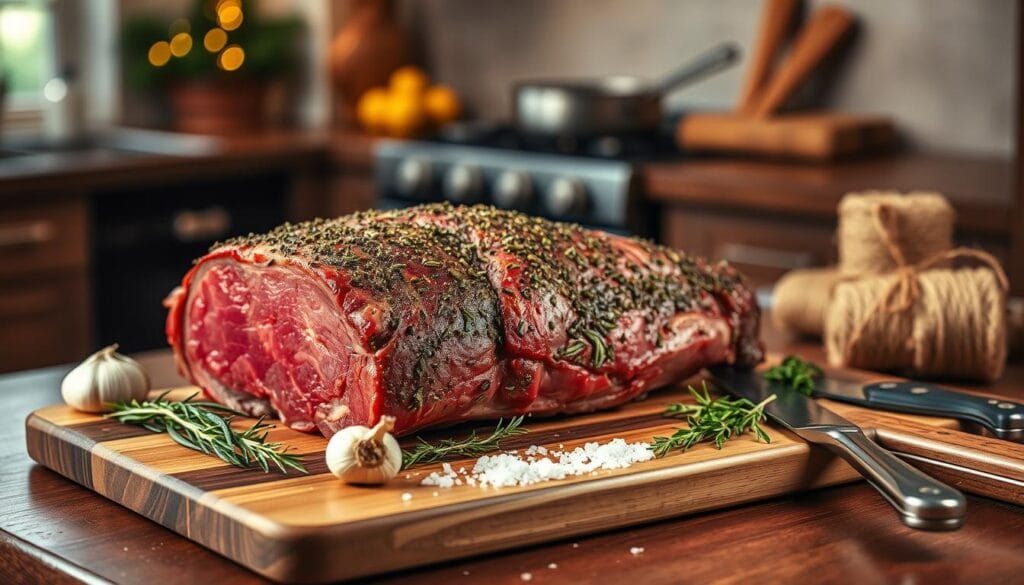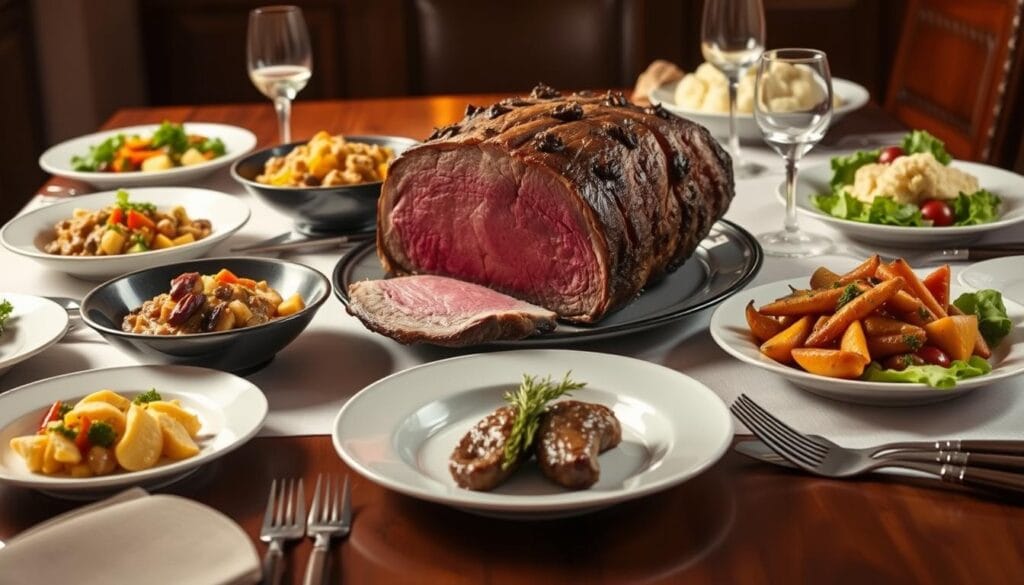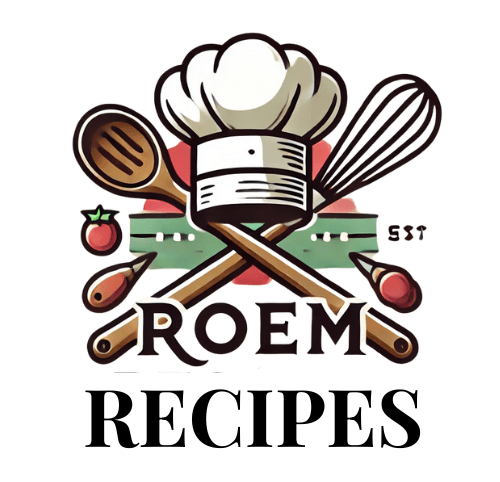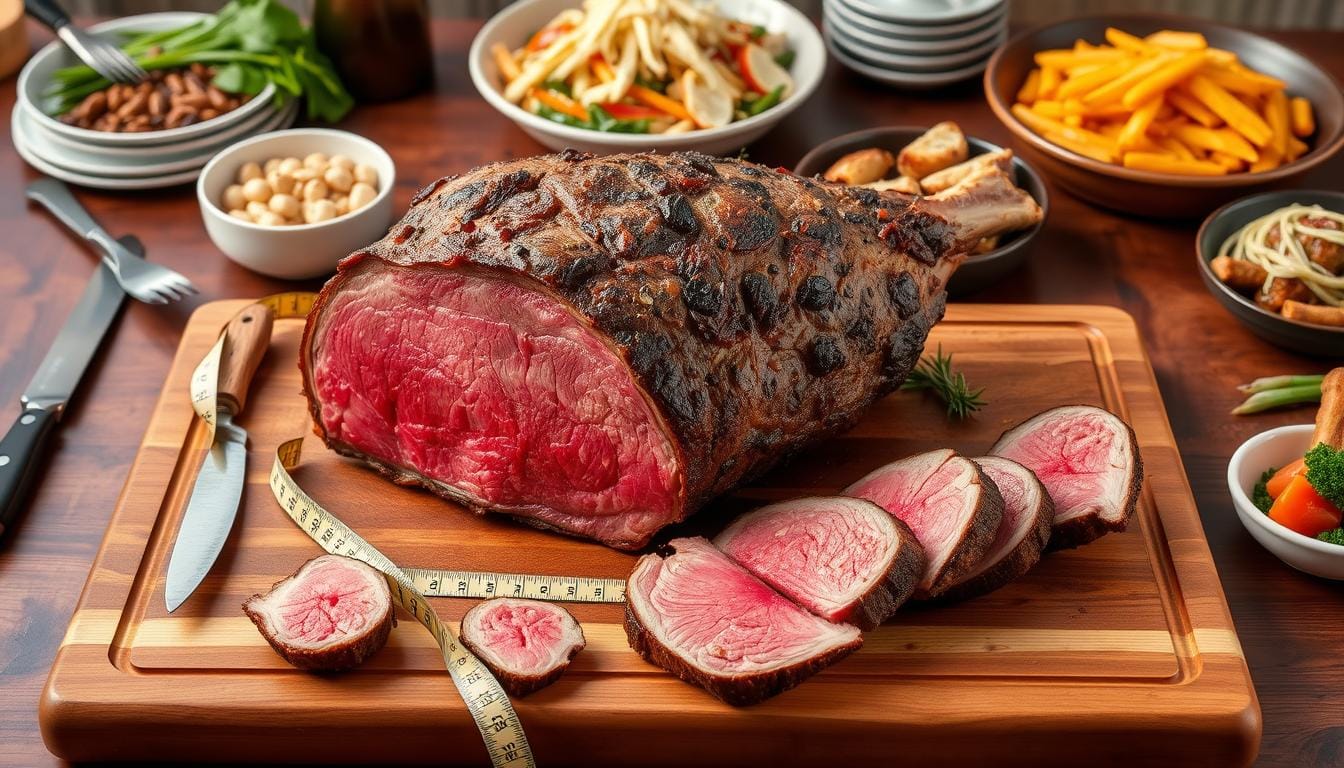The smell of a perfectly roasted prime rib can make any event special. Imagine the rich scent of seasoned beef filling your kitchen. You know you’ve picked the perfect prime rib roast for a memorable holiday centerpiece.
Choosing the right prime rib roast size is more than just feeding your guests. It’s about creating a special culinary experience that brings everyone together. Whether it’s a small family dinner or a big holiday feast, picking the right roast is crucial.
A prime rib roast is a feast of flavors, tradition, and cooking art. From choosing the right cut to making sure there’s enough for everyone, this guide will help you confidently navigate the world of prime rib.
Key Takeaways
- Prime rib roast is the ultimate holiday centerpiece
- Size matters: Plan approximately ¾ pound per person
- Consider bone count when selecting your roast
- Prime grade beef offers superior marbling and flavor
- Proper sizing prevents both shortage and excessive leftovers
Understanding Prime Rib: A Premium Holiday Centerpiece
The prime rib cut is a true showstopper for holiday meals. It’s the top of beef excellence, offering unmatched flavor and tenderness. This makes any special occasion unforgettable.

The prime rib comes from the most tender part of the beef. It promises a dining experience that will wow even the pickiest eaters. Let’s dive into what makes this cut so special.
What Makes Prime Rib Special
- Incredible marbling that ensures exceptional flavor
- Tender meat with a rich, buttery texture
- Versatile cooking options for different preferences
- Premium cut that elevates any holiday meal
Bone-in vs. Boneless Prime Rib
Choosing between bone-in and boneless prime rib depends on your cooking style and presentation. A bone-in prime rib adds extra flavor and acts as a natural roasting rack. On the other hand, a boneless prime rib is easier to carve and slice evenly.
Prime Rib vs. Ribeye Differences
Many people confuse prime rib with ribeye steak, but they’re not the same. A ribeye steak is a single cut from the prime rib roast, often grilled or pan-seared. The prime rib roast, however, is the whole section roasted whole. This keeps its moisture and flavor intact.
“The prime rib is not just a meal, it’s a culinary experience that brings families together.” – Professional Chef
Whether you choose a bone-in or boneless prime rib, you’re in for a luxurious dining experience. It’s sure to create lasting memories.
How Much Does a 5 lb Prime Rib Roast Feed?

Planning a perfect prime rib dinner means knowing how many it will serve. A 5 lb prime rib roast is great for 4-5 people. It’s perfect for a small gathering or a cozy family dinner.
How you serve it depends on the meal. For a formal dinner, give each person a pound. At a buffet with many dishes, half a pound is enough. This way, you can figure out how many will enjoy your 5 lb prime rib.
“The key to a successful prime rib dinner is knowing your crowd and planning accordingly.”
Serving Size Breakdown
- Sit-down dinner: 1 pound per person
- Holiday buffet: 1/2 pound per person
- Potential servings for a 5 lb prime rib: 5-8 people
The number of servings can change for different reasons. Bone-in roasts have less meat than boneless ones. If you’re serving big eaters or teenagers, you might need more.
| Roast Weight | Typical Servings | Buffet Servings |
|---|---|---|
| 5 lb prime rib | 4-5 people | 6-8 people |
When you’re cooking your 5 lb prime rib, think about the sides and your guests’ hunger. A well-planned roast makes sure everyone is happy and full.
Essential Prep Work Before Cooking Your Prime Rib
Preparing a prime rib roast needs careful attention. Professional butchers say it all starts before the roast goes in the oven. Your prep work can turn a good meal into an unforgettable experience.
Room Temperature Strategy
Getting your prime rib to room temperature is key. Take it out of the fridge 30-45 minutes before cooking. This step ensures even cooking and the perfect doneness. Professional chefs agree it’s essential for great results.
Meat Thermometer Precision
A good meat thermometer is vital for prime rib prep. Use a digital instant-read thermometer for accurate readings. For prime rib, aim for these internal temperatures:
- Rare: 120-125°F
- Medium Rare: 125-130°F
- Medium: 130-135°F
Butcher Preparation Tips
Talking to your local butcher can improve your prime rib. Ask them to:
- Trim excess fat (but keep a thin layer)
- French the bones for a fancy look
- Tie the roast for even cooking
“The secret to a perfect prime rib is in the preparation.” – Professional Chef
Prime Rib Size Calculator: Guest Count Guide
Planning the perfect prime rib for your dinner party can feel like solving a culinary math problem. Your prime rib calculator starts with understanding how much meat you’ll need per guest. A solid guideline is to purchase one pound of bone-in prime rib per person, ensuring everyone leaves satisfied.
“The secret to a perfect dinner party is having just enough prime rib to keep your guests happy without overwhelming your budget.”
When calculating your prime rib portions, consider these key factors:
- Bone-in prime rib typically serves two people per bone
- Plan for 1 pound per person for sit-down dinners
- Reduce to 1/2 pound per person for buffet-style meals
Here’s a comprehensive prime rib size guide for 10 adults:
| Guest Count | Roast Weight | Number of Bones |
|---|---|---|
| 3-4 people | 4 pounds | 2 bones |
| 4-5 people | 5 pounds | 2-3 bones |
| 8-10 people | 10 pounds | 5 bones |
| 10-12 people | 14 pounds | 7 bones |
For boneless prime rib, adjust your calculations to approximately 3/4 to 1 pound per person. Remember, it’s always better to have slightly more meat than not enough. Your guests will appreciate the generous portion, and leftovers can be a delightful bonus.
Perfect Seasoning Techniques for Prime Rib
To make your prime rib truly special, learn the art of seasoning. The right seasoning can turn a simple roast into a dish that wows your guests. It will also make their taste buds dance with joy.
Seasoning your prime rib is more than just adding salt and pepper. It’s about making a flavor mix that brings out the meat’s richness. You also want to create a crust that’s both crispy and delicious.
Classic Salt and Pepper Crust
The base of any great prime rib seasoning is a strong salt and pepper crust. Here’s how to do it right:
- Use coarse kosher salt for maximum flavor penetration
- Freshly ground black pepper provides a sharp, aromatic kick
- Apply the seasoning generously, covering the entire roast
- Let the seasoned meat sit uncovered in the refrigerator to dry out the surface
Herb and Garlic Combinations
Enhance your herb rub with fresh herbs and garlic. A classic mix includes:
- Chopped fresh rosemary
- Thyme leaves
- Minced garlic
- Olive oil to help herbs adhere to the meat
Advanced Seasoning Blends
If you’re feeling adventurous, try these advanced seasoning options:
| Ingredient | Flavor Profile |
|---|---|
| Brown Sugar | Adds subtle sweetness |
| Paprika | Provides mild smokiness |
| Lemon Zest | Brings bright, citrusy notes |
| Oregano | Introduces Mediterranean flair |
“The secret to an unforgettable prime rib is not just in the cooking, but in the seasoning that happens long before it hits the heat.” – Professional Chef
Pro tip: Always season your prime rib at least 2 hours before cooking, or ideally the night before. This lets the flavors soak deep into the meat.
Temperature and Timing Guidelines
Mastering the prime rib cooking time is key to a perfect roast. You need to know the exact oven temperature and cooking time. Professional chefs say to cook for about 15 minutes per pound of prime rib.
- Preheat oven to 450°F for initial searing
- Reduce temperature to 325°F for remaining cooking time
- Use a meat thermometer to check internal temperature
“The key to a perfect prime rib is precision in temperature control and timing.” – Chef Michael Roberts
Knowing when your prime rib is done is crucial. Professional chefs suggest specific internal temperatures for different tastes:
| Doneness Level | Internal Temperature |
|---|---|
| Rare | 120-125°F |
| Medium Rare | 130-135°F |
| Medium | 140-145°F |
Remember, your roast will keep cooking while it rests. Always take the prime rib out of the oven 5-10 degrees before your target temperature. This prevents it from getting overcooked.
Step-by-Step Cooking Method
Learning to cook prime rib needs care and patience. The right way to roast prime rib can turn a great cut into a memorable meal. Your aim is to make a roast that will wow your guests and please even the pickiest eaters.
Initial High-Heat Searing
Start by searing the prime rib at high heat. Dry the meat with paper towels for a perfect crust. Experts say to sear at 500°F for 3-4 minutes on each side. This step seals in the flavors and gives a golden-brown look.
Low and Slow Roasting
After searing, move to slow roasting. Put the roast in a pan, fat side up. Lower the oven to 225°F and cook until it’s done to your liking:
- Rare: 115-120°F
- Medium Rare: 125-130°F
- Medium: 135-140°F
Resting Period Essentials
Resting the meat is key, but often missed. When the prime rib is cooked, take it out and cover it with foil. Let it rest for at least 20 minutes. This step makes the meat tender and juicy.
“Patience during resting is the secret to a perfect prime rib.” – Culinary Experts
Pro tip: Use a meat thermometer to check the temperature. Take it out a few degrees before your target. This way, it will cook a bit more while resting.
Achieving Your Desired Doneness Level
Mastering prime rib doneness is an art that makes your roast truly special. The meat’s temperature is key to its taste and texture. Getting it right is crucial for a memorable meal.
Knowing the right temperatures for each doneness level is essential. This guide will help you achieve the perfect medium-rare prime rib every time:
- Rare: 120-125°F (bright red center)
- Medium-rare: 130-135°F (warm pink center)
- Medium: 140-145°F (light pink center)
- Medium-well: 150-155°F (slight pink center)
- Well-done: 160°F+ (no pink)
“The secret to a perfect prime rib is knowing exactly when to pull it from the oven.” – Professional Chef
Carryover cooking adds 5-10 degrees to the internal temperature while resting. So, remove your roast a bit before reaching your target temperature.
| Doneness Level | Internal Temperature | Appearance |
|---|---|---|
| Rare | 120-125°F | Bright red center |
| Medium-rare | 130-135°F | Warm pink center |
| Medium | 140-145°F | Light pink center |
Pro tip: Always use a reliable meat thermometer for accuracy. Cooking beyond medium can make the prime rib dry and tough. Aim for medium-rare for the best tenderness and juiciness.
Common Prime Rib Cooking Mistakes to Avoid
Preparing a prime rib roast needs precision and care. Many home cooks make mistakes that can ruin a meal. Knowing these errors can help you cook with confidence.
One big mistake is overcooking the prime rib. It’s crucial to watch the meat’s temperature closely. A reliable meat thermometer is essential for the perfect doneness.
- Avoid opening the oven door too often, as it changes the temperature
- Don’t just rely on cooking time to check if it’s done
- Always let the meat rest before carving
“Patience is the secret ingredient in preparing the perfect prime rib.” – Professional Chef
Remember these prime rib tips: Bring your roast to room temperature before cooking. Also, let it rest long enough. Cutting into the meat too soon can make it dry and less tasty.
| Common Mistake | Recommended Solution |
|---|---|
| Not using a meat thermometer | Always check internal temperature |
| Skipping room temperature rest | Let meat sit out for 1-2 hours before cooking |
| Cutting immediately after cooking | Rest meat 10-15 minutes before slicing |
Avoiding these mistakes will greatly improve your prime rib’s quality. You’ll make sure your meal is memorable for everyone.
Serving and Presentation Tips
Learning how to carve prime rib can make a great roast even better. It’s not just about cutting the meat. It’s about making a moment that your guests will remember.
Professional Carving Techniques
To carve prime rib like a pro, follow these steps:
- Use a sharp carving knife with a long, thin blade
- Remove bones before slicing if they’re attached
- Slice against the grain into 1/2 to 3/4 inch thick pieces
- Maintain consistent slice thickness for elegant presentation
Elegant Plating Strategies
Make your prime rib look stunning with these tips:
- Select a warm, large serving platter
- Arrange slices slightly overlapping
- Garnish with fresh herbs like rosemary or thyme
- Serve with complementary sauces on the side
| Sauce Pairing | Flavor Profile |
|---|---|
| Classic Au Jus | Rich, meaty drippings |
| Horseradish Cream | Tangy and sharp |
| Herb Butter | Creamy and aromatic |
“Presentation is the final art form in cooking – it’s where technique meets creativity.” – Professional Chef
The secret to a great prime rib presentation is precision and thought. Your guests will be impressed by your skills!
Storing and Repurposing Leftover Prime Rib
After enjoying your delicious prime rib roast, you’ll want to make the most of your leftovers. Storing roast beef correctly ensures you can savor every delectable bite in the days following your original meal.
When it comes to storing prime rib leftovers, follow these key guidelines:
- Store in an airtight container
- Refrigerate within 2 hours of cooking
- Keep for 3-4 days maximum
- Maintain refrigerator temperature below 40°F
Leftover prime rib recipes offer exciting culinary opportunities. Your remaining roast can transform into multiple delicious dishes:
- Gourmet Sandwiches: Thinly slice for premium beef sandwiches
- Beef Stroganoff: Cube and add to creamy pasta dishes
- Beef Tacos: Shred for a quick Mexican-inspired meal
- Steak Salad: Slice and top fresh greens
| Dish | Preparation Time | Servings |
|---|---|---|
| Prime Rib Tacos | 10 minutes | 6 servings |
| Beef Stroganoff | 15 minutes | 4 servings |
| Steak Salad | 5 minutes | 2 servings |
Reheating requires gentle care. Bring meat to room temperature, then warm in a low oven (250°F) or quickly sear in a hot pan. This prevents overcooking and maintains the prime rib’s tender texture.
“The secret to great leftover prime rib is gentle reheating and creative repurposing.” – Professional Chef
With these tips, your prime rib leftovers will be just as enjoyable as the original roast. They offer versatile and delicious meal options throughout the week.
FAQ
How many people will a 5 lb prime rib feed?
How long does it take to cook a 5 lb prime rib roast?
What size prime rib roast do I need for 15 people?
How much prime rib should I prepare for 4 adults?
How much boneless prime rib should I serve per person?
How much prime rib do I need for 10 adults?
What’s the recommended internal temperature for prime rib?
Should I choose bone-in or boneless prime rib?
Conclusion
Making the perfect prime rib takes patience, skill, and detail. Your journey starts with picking the right cut and knowing how to cook it. USDA Prime or Choice grades are best for flavor and marbling, making your meal unforgettable.
Preparing a prime rib roast is more than just cooking. You need to choose the right size and keep an eye on the internal temperature. Options like bone-in or boneless from places like Costco can make your meal stand out.
Getting better at making prime rib takes practice. You’ll learn about seasoning, cooking times, and resting periods. Remember, the meat shrinks while cooking, so plan ahead. With these tips, you’ll create a dish that wows everyone.
As you get more confident in making prime rib, you’ll improve with each try. Don’t be afraid to try new things and adjust to your liking. A delicious, perfectly cooked prime rib is just a step away.

